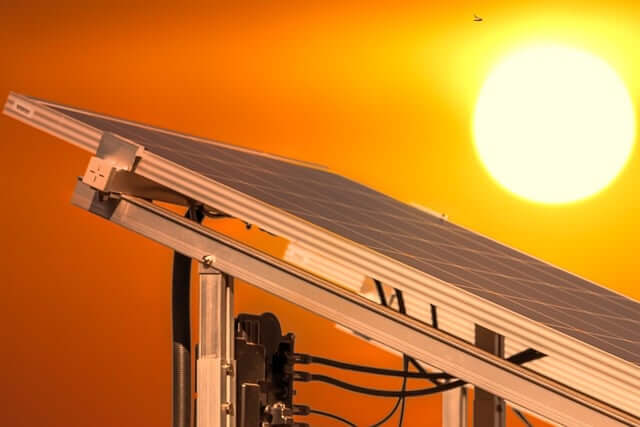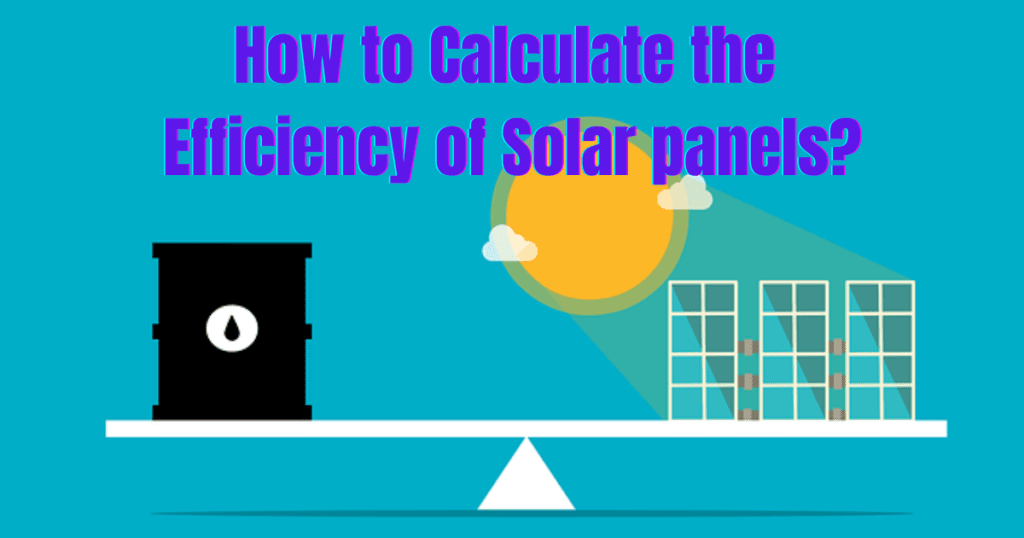Last updated on March 30th, 2024 at 04:02 pm
Understanding and calculating the efficiency of solar panels is paramount for anyone seeking to harness the full potential of solar power. Efficiency is the heartbeat of solar panels, dictating their ability to harness sunlight and convert it electricity.
This article is your gateway to unlocking the formula for success in solar power generation. By delving deep into the intricacies of calculating efficiency of solar panels, we promise not only clarity on the fundamental formula but a holistic understanding that empowers you to make informed choices in navigating the dynamic landscape of solar energy. Lets dive in to understand the efficiency of solar panels!
2.Understanding the efficiency of solar panels is important for reducing installation costs, enhancing the return on investment, and optimizing your energy needs
3. High efficiency solar panel exhibits efficiency greater than 23%
4. Influential factors such as sunlight intensity, tilt angle, orientation, temperature, and shading affect the efficiency of solar panels.
Solar Panel Efficiency Calculator
What is the efficiency of a solar panel?
The efficiency of solar panels is a measure of how well they convert sunlight into usable electrical energy. It is typically expressed as a percentage and represents the ratio of the electrical power output of the solar panel to the solar energy input from the sun. The higher the efficiency, the more effective the solar panel is at converting sunlight into electricity.
Importance of understanding the efficiency of solar panels
Solar panel efficiency is a critical factor that significantly influences the overall performance and viability of solar energy systems. The importance of efficiency can be understood through various aspects that impact the functionality, economic viability, and environmental benefits of solar panels.
Maximizing Energy Production
High-efficiency solar panels generate more electricity for a given amount of sunlight. This is particularly crucial in regions with limited sunlight or during periods of low solar intensity. Maximizing energy production ensures that solar power systems can meet the demand for electricity more effectively.
Optimizing Limited Space
In many installations, space is a premium. High-efficiency solar panels allow for the generation of more power within a limited area, making them ideal for rooftop installations, urban environments, and other situations where space constraints are a concern.
Reducing Installation Costs
Efficient solar panels require fewer modules to generate a specific amount of electricity compared to lower-efficiency counterparts. This not only reduces the amount of physical space needed but also lowers the overall installation costs, including support structures, wiring, and associated components.
Enhancing Economic Viability
Solar panel efficiency directly impacts the economic viability of solar energy projects. Higher efficiency means a better return on investment over the lifespan of the solar panels, as more energy is produced, and maintenance costs are distributed over a greater output.

Key parameters to calculate the efficiency of a solar panel
Efficiency calculation for solar panels involves key parameters such as solar irradiance, power output and area of solar panel that provide insights into their performance. Understanding these parameters is crucial for evaluating the effectiveness of a solar energy system.
1. Determine the Solar Irradiance
Solar irradiance is the power per unit area received from the sun in the form of electromagnetic radiation. It is usually measured in watts per square meter (W/m²). Under standard test conditions (STC), the irradiance level is set at 1000 watts per square meter (W/m²). This value provides a standardized reference point for evaluating solar panel efficiency and performance.
While STC conditions provide a standardized reference, the actual irradiance a solar panel experiences in the field can vary based on factors such as location, time of day, and weather conditions. You can find average solar irradiance values for your location from solar resource maps or databases.
2. Calculate the Solar Panel Output Power
The output power of a solar panel is the electrical power it generates under standard test conditions (STC). STC conditions are defined as a solar irradiance of 1000 W/m², a cell temperature of 25°C, and the sunlight hitting the panel at a specific angle (known as the air mass 1.5 spectrum). You can find the rated power (Pmax) of a solar panel in its datasheet provided by the manufacturer, typically given in watts (W). Pmax is the wattage of a solar panel.
3. Determine the Area of the Solar Panel
The area of the solar panel is the physical surface that captures sunlight. It is usually measured in square meters. You can calculate the area by multiplying the length and width of the solar panel. The dimensions and area of a residential of solar panels can vary. Normally residential solar panels have length 1.65 m, width 0.99 m and area of 1.635 m².
Formula to calculate the efficiency of a solar panel
Solar panel efficiency (η) is calculated using the formula:
Efficiency (η) in % =[Output Power/(Solar Irradiance × Panel Area)]×100
=[Output Power/(Solar Irradiance × Length of Panel Area × Width of Panel Area)]×100
- Output Power is the rated power of the solar panel (Pmax). It is the wattage of your solar panel in Watt.
- Solar Irradiance is the average solar irradiance in your location (in W/m²). It is usually used as 1000 W/m² for the calculation of the efficiency of a solar panel.
- Panel Area is the total surface area of the solar panel (in square meters). The area of the solar panel can be calculated by the length multiplied with the width of solar panel.
Let’s say you have a solar panel with a rated power (Pmax) of 300 watts, a solar irradiance of 1000 W/m², panel length 1.62 m, panel width 1.11 m and a panel area of 1.8 m². The efficiency would be calculated as follows:
Efficiency (%) =[300W/(1000W/m² × 1.62m × 1.11 m)]×100
=[300W/(1000W/m² × 1.8 m²)]×100
Efficiency of your solar panel (η)=16.67%
Solar cell efficiency vs. solar panel efficiency
Solar cell efficiency is a crucial metric that gauges the capability of an individual photovoltaic cell to convert sunlight into electrical energy. It serves as a key indicator of how efficiently a single cell can harness solar energy and transform it into usable electricity.
The quest for higher solar cell efficiency is a driving force in solar technology research and development. Innovations aim to enhance the performance of individual cells, allowing them to convert a larger proportion of sunlight into electricity.
In contrast to solar cell efficiency, solar panel efficiency considers the collective performance of an entire solar panel, which comprises interconnected solar cells. This metric provides a more comprehensive understanding of how well the entire system operates in practical, real-world conditions. Solar panel efficiency takes into account not only the efficiency of individual cells but also factors related to the arrangement, interconnection, and overall design of the panel.
Solar cell efficiency is typically used by researchers, scientists, manufacturers, engineers, and educators focusing on the development and improvement of individual solar cells and associated materials. On the other hand, solar panel efficiency finds application among solar system designers, architects, homeowners, businesses, investors, and renewable energy consultants.

High efficiency solar panels of 2024
The efficiency of solar panels varies across different technologies and types of solar cells. Monocrystalline solar panels, made from single-crystal silicon, are known for their high efficiency. On average, these panels can achieve efficiencies ranging from 15% to 22%. Some premium monocrystalline panels can even exceed 23%.
Polycrystalline solar panels are made from multiple crystal structures and are generally less efficient than monocrystalline panels. Their efficiency typically ranges from 13% to 18%. In addition, thin-film solar panels typically have efficiencies in the range of 10% to 12%. Some thin-film solar panels, such as copper indium gallium selenide (CIGS) achieved more than 23% efficiency in laboratory condition.
Here is the list of 5 high efficiency solar panels of 2024:
Recom Black Tiger Series: The Recom Black Tiger series, boasting an impressive efficiency of 23.6% with 440-460 W power output, integrates advanced solar technologies, including N-type half-cut cells and back-contact design.
LONGi Hi-MO 6 Scientist: The LONGi Hi-MO 6 Scientist series boasts an efficiency of 23.2%, a power output ranging from 580W to 600W, and utilizes back-contact soldering technology.
Huasun Himalaya G12 Series: Huasun Himalaya G12 Series featuring N-type 210mm HJT solar cells with power output range of 625W to 720W and module efficiency of 23.18%.
Aiko Black Hole series: Aiko Black Hole series featuring N-type monocrystalline solar cells with power output range 450W and efficiency of 22.8%
Sunpower maxeon 6: Sunpower maxeon 6 featuring IBC monocrystalline N-type solar cells with power output range of 425W to 435W and efficiency of 22.6%.
Factors affecting the efficiency of solar panels
Several factors can impact the efficiency of solar panels, influencing their ability to convert sunlight into electricity. Key factors include:
1. Sunlight Intensity and Angle
The angle and intensity of sunlight directly affect a solar panel’s performance. Panels operate most efficiently when they receive sunlight at perpendicular angles and under high irradiance levels.
2. Temperature
Solar panels can experience reduced efficiency as temperatures rise. High temperatures can lead to increased resistance in the solar cells, affecting their ability to generate electricity.
3. Shading
Even partial shading of a solar panel can significantly reduce its efficiency. Shading obstructs the flow of sunlight to cells, leading to uneven power generation and potential damage to the shaded cells.
4. Dust and Debris
Accumulation of dust, dirt, or debris on the surface of solar panels can decrease light absorption, reducing the overall efficiency. Regular cleaning is essential for optimal performance.
5. Panel Orientation and Tilt
Proper alignment and tilt of solar panels are critical for maximizing energy absorption. Incorrect orientation or tilt can result in suboptimal sunlight exposure and decreased efficiency.
6. Quality of Materials and Manufacturing
The quality of materials used in solar panels and the manufacturing processes employed can impact their long-term performance. High-quality materials and precise manufacturing contribute to better efficiency and durability.
7. Age and Degradation
Over time, solar panels may experience degradation, leading to a gradual reduction in efficiency. Manufacturers typically provide degradation rates to estimate performance over the panel’s lifespan.
8. Mismatched Panels
If solar panels in an array have different specifications or are mismatched, it can lead to varied power outputs, reducing overall efficiency. Uniformity in panel characteristics is essential for optimal performance.
9. Reflection and Glare
Surrounding surfaces reflecting sunlight onto solar panels or glare from nearby structures can affect panel performance. Minimizing such reflections enhances overall efficiency.
10. System Design and Wiring
The design of the entire solar power system, including the wiring and connectivity, influences efficiency. Proper design minimizes energy losses and ensures optimal energy transfer.
Conclusions
In conclusion, the efficiency of solar panels plays an important role in the widespread adoption of solar energy. By considering key factors such as the rated power of the panel, solar irradiance, and panel area, individuals can obtain valuable insights into the performance of their solar energy systems. This knowledge empowers users to optimize the design and placement of solar panels, ultimately maximizing energy output.

